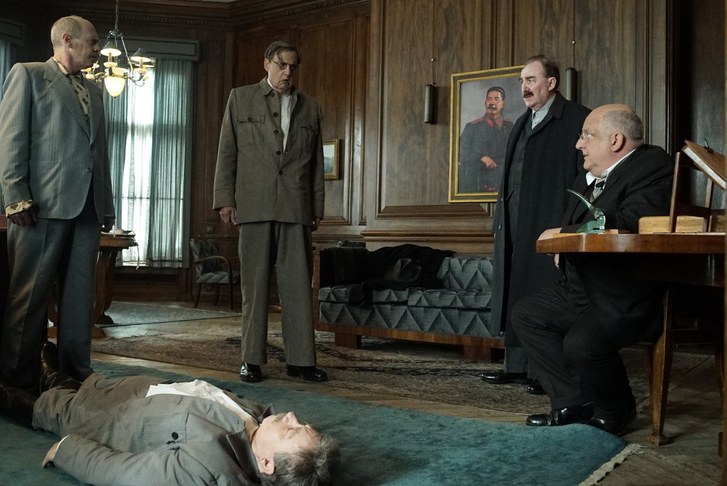 Anyone looking for something diverting to see over the weekend should head to Amazon or iTunes to stream the new digital release “The Death of Stalin.” The film builds itself on paradoxes that are both intratextual and extratextual. The phrase “your mileage may vary” seems created for the bizarre, relentless humour that defines the comedic antics of the film, and yet everything about it, from sharp script to its impressive editing, announces it as an essential viewing. The film itself (based on a French graphic novel) attempts to satirise Stalinism and the ensuing race for power that comes in the wake of Joseph Stalin’s death in a turbulent Soviet Union only a decade after World War II. All the while the film performs this satire with a mix of familiar (and less familiar) character actors playing key figures in 1950s USSR politics not as real persons come to life but as extensions of their own familiar sensibilities. Like I said, the film itself strains credulity with aspects that seem counterintuitive within themselves, and yet the final product, teeming with death, the deadly and the macabre, feels decidedly compulsory.
Anyone looking for something diverting to see over the weekend should head to Amazon or iTunes to stream the new digital release “The Death of Stalin.” The film builds itself on paradoxes that are both intratextual and extratextual. The phrase “your mileage may vary” seems created for the bizarre, relentless humour that defines the comedic antics of the film, and yet everything about it, from sharp script to its impressive editing, announces it as an essential viewing. The film itself (based on a French graphic novel) attempts to satirise Stalinism and the ensuing race for power that comes in the wake of Joseph Stalin’s death in a turbulent Soviet Union only a decade after World War II. All the while the film performs this satire with a mix of familiar (and less familiar) character actors playing key figures in 1950s USSR politics not as real persons come to life but as extensions of their own familiar sensibilities. Like I said, the film itself strains credulity with aspects that seem counterintuitive within themselves, and yet the final product, teeming with death, the deadly and the macabre, feels decidedly compulsory.
Armando Iannucci’s brand of political humour (best seen in TV series “Veep” and “The Thick of It” and the transatlantic production “In the Loop”) is distinctive enough that anyone going into “The Death of Stalin” might be able to anticipate what at first seems like aspects of his dramaturgy–non sequitur line readings, farcical scenarios, the pettiness of everyone from the top to the bottom. Consider the film’s opening gambit. An excellent pianist performs brilliantly on Radio Moscow, so brilliantly that Stalin calls for a recording of the production. But what has been recorded? Alas nothing. And, so, the producers must hasten to solve this issue by recreating the orchestra, but not before some blackmail from the pianist, and not before the conductor faints in fright, and not before a large section of the audience leaves, forcing them to call in nonplussed peasants to fill the room. This opening is a sleight of hand though. It sets up the inherent silliness of the world, but very soon upends it. For very soon, as Stalin receives the (fake) recording, he drops dead – a mere 15 minutes into the film. Death is the thing that marks the affair, the peripheral nature of human life in a world that’s dreadfully violent. It’s a key aspect that differentiates this from Iannucci’s previous works – and it’s the kicker on which “The Death of Stalin” hangs.
In using The Russian Empire as a backdrop for his usual comedy, Iannucci is able to draw on a level of violence that is simultaneously horrifying and compelling, and the film is made all the more discomfiting and funny for it. A common theme in Iannucci’s characters is their penchant for frustration. Frustration manifests itself verbally, which is why his work is so verbal, but with death added to the stakes frustration in this world manifests itself in violence and violence is often a signal for impending death, and death is visual. There’s an impressive visual nature to the comedy (and the horror) in “The Death of Stalin” that signals Iannucci’s creativity not just as a writer (he co-writes the film with a team comprising David Schneider, Ian Martin, Peter Fellows) but as a director I’m not certain that the film is immediately better than his previous directorial work, but there’s a visceral nature to the way it interacts with bodies and tableaus that is striking.
There is a key sequence immediately after the confirmation of Stalin’s death when the dead leader’s Committee leaves with the body and the house is immediately pounced upon by members of the military. The sequence runs for about 90 seconds as they tear through the house in the violent fashion one would expect of a country on the brink of political upheaval. The moment is pulsating as the first of a number of sequences that is at once jarring and beguiling for the way it performs a sort of deathly symphony. This montage is key among others to come that establish Iannucci’s ability to be just as compelling without dialogue, something that might not have seemed as obvious before.
Of the main cast, Steve Buscemi, speaking in his typical New York vernacular, makes for an impressive Nikita Khrushchev. The film’s brave conceit depends on having each actor speak in their regular cadence, emphasising the incoherent and disparate nature of everyone fighting for control. It works, though, marvellously as we watch Simon Russell Beale lean into his Shakespearean roots as the unsubtle Beria, or watch Jeffrey Tambour using his natural sad sack demeanour to beautiful effect as the unwilling second in command to Stalin. The depth of the cast where everyone is working well means that we find gifts of brief turns further away from the main plot. Key among them is Andrea Riseborough as Svetlana, the daughter of the beefeater leader. Hers is the most significant female role and she’s marvellous, drawing our attention to the edges of the political upheaval. In a film that plays up its ridiculous nature, there is a brief moment where Svetlana and her brother Vasily (played by Rupert Friend) look at each other, recognising the sadness and despair of their situation. It is a brief but valuable moment where “The Death of Stalin” decides to contextualise the inherently farcical incidents that are playing out, and I found myself shocked at how moved I was, even as I laughed. Iannucci’s biggest accomplishment is to arrest our sympathy even amidst our incredulity at the bacchanal nature of the situation. The unwavering veneer of ridiculousness does make the sequences of violence easier to watch but I found myself surprised and impressed by the sadness that seeped through the chuckles.
It’s the ultimate power of historic dissemblance that Iannucci is playing with here. The comparison might seem bizarre but it reminds me of Pablo Larrain’s marvellous take on Jackie Kennedy’s grieving process in 2016’s “Jackie.” That tale was a version of history as body horror whereas Iannucci’s sets up history as bathetic farce. Both depend on the way they hew close to history and then violently away from them, but the effect is lacerating for how they come to scrutinise the audience by the time the credits roll. The last sequence of deaths in “The Death of Stalin” take on horrific proportions that sound the death knell of reality, but the actions in this version make a weird sort of sense. When the film ends, Iannucci seems to have invited us to rethink our relationship with the past and with present politicking. It’s to his great credit that he does it all while making sides ache from laughing.
Death of Stalin is streaming for free on Amazon Prime and is also available for rent on regular Amazon, iTunes, and GooglePlay Movies.










